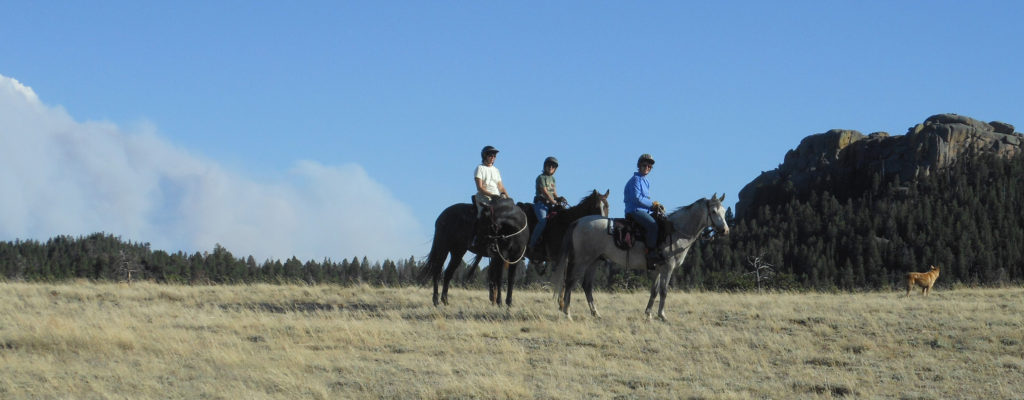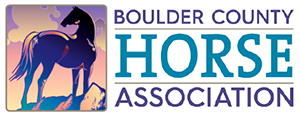
There is nothing better than a trail ride, and today’s equestrians have to share the trail with all types of users—from hikers to cyclists to even llamas!
Having a positive trail experience requires cooperation, understanding and courtesy. Below a a few tips to make sure you have a safe and fun trail experience. Many people who are not familiar with horses often ask: How do I safely approach a horse on the trail? Like people and dogs each horse is different and has its own personality, what spooks one horse might be “old hat” to another, so please use these guidelines if you see a horse on the trail.
Approaching a horse from the front
Stop and check with the rider. If necessary, step off the trail on the downhill side to allow the horse to pass. The equestrian will often have the best suggestion about how to pass their horse.
Approaching a horse from the rear
When approaching a horse from behind, call out to the rider and horse when you think they can hear you. Continue calling until you get a response.
A few suggestions:
- Speak to the horse in a normal tone of voice to identify yourself as a human.
- Make yourself visible, try not to crouch.
- Keep calm and avoid sudden movements which might startle a horse.
- If possible, allow the horse to be on the uphill side of you. Something unfamiliar from above a horse may trigger an instinctual fear of a predator jumping down on it.
- Be alert for instruction from the equestrian (rider).
- If you have a dog, please place him/her on a leash until they pass.
- If you are sitting off the side of a trail and see a horse and rider approaching let them know you are there by saying hello
For Riders: Know the Trail
Be aware that other trail users don’t always know or follow trail etiquette, nor have experience with horses.
- Have a map and be prepared for the terrain and changing weather conditions.
- Check trail conditions before heading out, and make sure that both you and your horse are in condition for the type of terrain the trail covers.
- Allow adequate time to complete your route before dark, unless you are prepared for nighttime trail conditions.
- Recognize and respect different levels of ability within your group, and place less experienced horses amongst those more seasoned.
- Have the proper hoof protection for trail conditions. Carry an EasyCare boot or other hoof protection in case your horse throws a shoe.
Equestrian Safety
Take the time to check your trailer tires, coupling and inside for wasp nests before loading. Check your saddle and equipment before starting out on the trail, and be sure your gear is fastened securely. Carry water and a emergency kit that contains items for both you and your horse.
Let others know if special care is needed to pass your horse safely. Start a conversation as soon as possible. It may be advisable for you to find a place to get off the trail, facing oncoming traffic. Horses tend to feel safer on the high side of the trail. Although horses have the right of way, a horse leaving the trail briefly may have less impact on the terrain than another type of user doing so. For example, when feasible, horses may yield the right of way to OHVs coming uphill since stopping or shutting off engines on a steep grade may be risky. Take responsibility for your horse’s training. Expose your horse to a variety of situations to desensitize it to potential threats before you encounter them on the trail.
- Although other users are expected to yield to equestrians, assume they are unaware of trail etiquette.
- Let other users know when it is safe to pass your horse.
- Before passing other users, call out “passing” and then pass with care.
- Slow to a walk when approaching other trail users, including other equestrians.
At the Trailhead
Equestrians are encouraged to stay on designated trails and to clean up after your horse at trailheads. Manure should be taken home with you for proper disposal. If appropriate please spread the manure at the trailhead. The following guidelines will help make your ride more pleasant.
- Downhill traffic yields to uphill traffic
- Stay on designated trails and/or follow travel management regulations.
- Slow down when passing hikers.
- Avoid riding muddy trails but, if you must, ride through the mud, not around it.
- Respect private property.
- Never ride alone. If you must do so, tell someone where you plan to go and when you think you will be back.
- Maintain a safe distance between riders.
- Leave gates as you find them.
- Clean up your manure, carry out your trash and that of others.
- Volunteer for trail building and maintenance projects.
- Let the appropriate land manager know about any concerns you may have about a trail.
- Share your appreciation about good trail experiences with land managers
Cyclists Safety
Bicycles are swift, silent, and low to the ground in ways that resemble natural predators to a horse. Thus, they can trigger a flight response in a horse that may override even years of excellent training. For safety reasons, cyclists should always yield to horses and foot traffic. When approaching horses from any direction, make verbal contact by speaking calmly. Stop your bike and do not advance until you get a definite signal from the equestrian to pass. Resume speed only when you have passed safely. Skidding brakes cause a sudden noise and may frighten a horse.
Hiker Safety
High backpacks, children in high back packs, and baby strollers may spook a horse. Packs may disguise the fact that you are a person. When you encounter a horse, stop and speak to the rider as soon as possible. If you have a rambunctious dog with you please place it on a leash, or have your dog under voice control. If you are hiking with children, horses can be both interesting and scary. Check with the equestrian before approaching a horse, and ask permission for your child to pat the horse; most equestrians will be happy to oblige.
Off Highway Vehicles (OHV) Safety
Operators of OHVs must be alert to slower traffic, and need to understand that the sound and vibration of OHVs can scare horses. It may be best to stop and shut off your engine and allow the horse and rider to pass. Having the engine off also makes it easier to communicate with other trail users as well. Drivers should slow down around blind corners and anticipate the presence of other trail users. While your engine is running, be especially alert visually to compensate for your limited hearing ability. OHV operators may also find that removing your helmet helps calm horses by showing the horse that you are just a human in there.
Be courteous, be safe, and always have fun!
